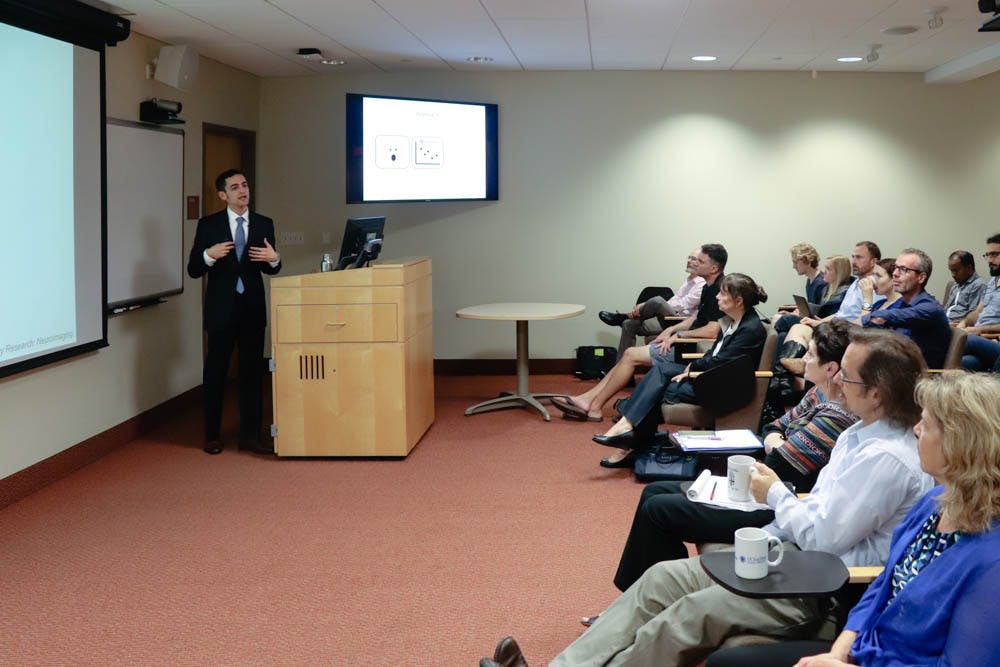Matthew Sacchet ’10, a postdoctoral scholar from Stanford University, delivered a lecture at the School of Public Health Tuesday on “personalized mindfulness practices,” according to the event description.
Sacchet began by pointing to a quote from Jon Kabat-Zinn, founding executive director of the Center for Mindfulness in Medicine, Health Care and Society at the University of Massachusetts Medical School, as a common definition of mindfulness: “paying attention in a particular way, on purpose, in the present moment and non-judgmentally.”
Sacchet added that he is “particularly interested in … moving beyond targeting psychiatric disorders and really trying to target specific individuals (and tailoring) mindfulness-based interventions for what that specific person needs.”
There are several questions in the field that still need to be answered, Sacchet said. “What is the neuroscience of mindfulness?” he asked. “How can we leverage the insights of the neuroscience of mindfulness to develop more effective treatments?”
In his lecture, Sacchet spoke about his research to better understand the brain structure and function of individuals with mood and anxiety disorders. His work may have applications in the field of mindfulness science.
While neuroscience has historically focused on the structure and function of specific brain regions, Sacchet said the field has recently shifted toward understanding how interactions between regions affect behavioral and psychological processes. Specifically, Sacchet aims to understand “how disruptions to these interactions might relate to psychopathology,” he added.
To explore this interest, Sacchet said he employed a variety of research methods, including diffusion-weighted magnetic resonance imaging, a technique that “allows an opportunity to investigate interregional (connections) non-invasively in humans.”
In one study, Sacchet applied a modeling method called brain tractography to investigate the robustness of the uncinate fasciculus, a white matter bundle located in the prefrontal cortex, in individuals with mood and anxiety disorders to understand how “that relates to … emotion regulation techniques that they use.”
From his research, Sacchet said he found that individuals with depression who engaged in emotional suppression — or the act of inhibiting emotional behavior such as keeping a poker face instead of expressing sadness — had a more robust uncinate fasciculus.
Emotional suppression is significant because it is, in some ways, “the opposite of a mindful approach” and “the opposite of acceptance,” he said.
Sacchet also discussed efforts to understand interregional interactions occurring in the brain through the use of functional magnetic resonance imaging and identification of brain structures that show highly correlated activity. In his lecture, Sacchet spoke about his analyses on three brain networks: the control network, which is involved in planning and the inhibition of impulses; the default network, which is involved in self-related processing; and the salience network, which is involved in determining items for future processing.
In one study, Sacchet used network analysis to study the control network in individuals with mood or anxiety disorders. During the experiment, participants were studied in both a resting state and while completing a cognitive control task. They found that individuals without these disorders showed modulation in this control network depending on the context they were in, but “individuals with depression did not exhibit this flexibility,” Sacchet said.
Judson Brewer, director of research and innovation at the Mindfulness Center, said he invited Sacchet to speak at the University because he is a “methodologic giant. He’s learned all of these different techniques and has started to apply those to look at clinical conditions.”
Referencing the University’s creation and expansion of the Mindfulness Center, Brewer added that he hoped Sacchet could get people “excited about the future of neuroscience and how it applies to personalized medicine (as well as) meditation and mindfulness.”
Dante Flores-Demarchi ’21 said he attended the lecture out of a personal interest in meditation, and was not aware of the ongoing research into mindfulness. “I found that (work) really inspiring,” he added.





